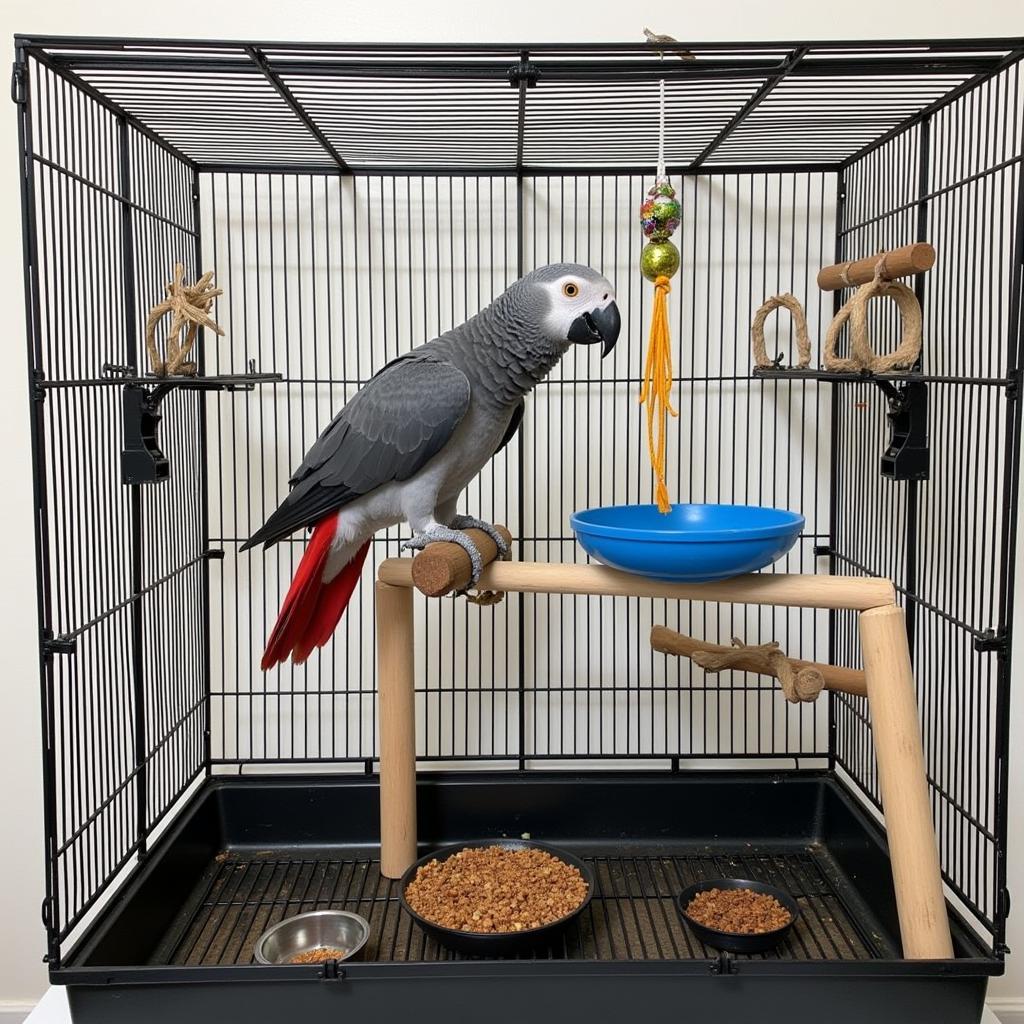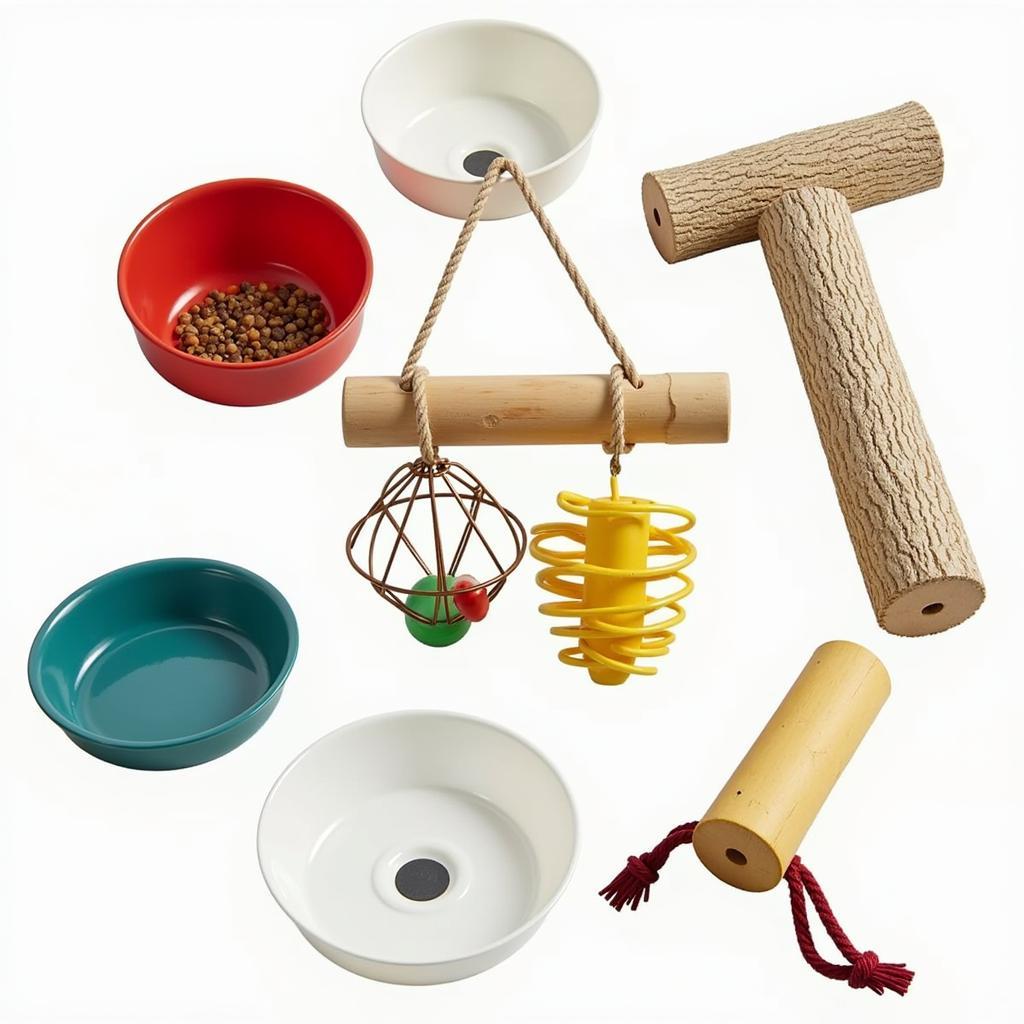The Ultimate Guide to African Grey Parrot Cage Setup
Setting up the perfect cage for your African Grey parrot is crucial for their well-being and happiness. These intelligent and social birds thrive in spacious, stimulating environments that cater to their physical and psychological needs. This comprehensive guide will walk you through everything you need to know about African Grey Parrot Cage Setup.
Choosing the Right Cage Size and Type
 African Grey Parrot in Spacious Cage
African Grey Parrot in Spacious Cage
When it comes to African Grey parrots, bigger is always better. A cramped cage can lead to stress, boredom, and even physical health problems. Aim for a cage that is at least:
- Width: 24 inches
- Depth: 24 inches
- Height: 36 inches
The cage should be spacious enough for your parrot to fully extend its wings without hitting the sides.
Cage Material:
Avoid cages made of galvanized metal, as the zinc coating can be toxic to parrots. Opt for cages constructed from:
- Stainless steel: Durable, non-toxic, and easy to clean
- Powder-coated wrought iron: Sturdy, attractive, and safe for parrots.
Essential Cage Accessories
 Essential African Grey Parrot Cage Accessories
Essential African Grey Parrot Cage Accessories
Creating a stimulating and enriching environment within the cage is vital. Here’s a breakdown of essential accessories:
1. Perches:
- Provide a variety of perches in different sizes, shapes, and textures.
- Natural wood perches are excellent for foot health.
- Avoid dowel perches, as they offer limited foot stimulation.
2. Food and Water Bowls:
- Choose stainless steel or ceramic bowls for easy cleaning.
- Provide two separate bowls – one for food and one for fresh water.
3. Toys:
African Greys are highly intelligent and require mental stimulation. Offer a rotating selection of toys, such as:
- Foraging toys: Engage their natural instincts and prevent boredom.
- Puzzle toys: Challenge their problem-solving abilities.
- Destructible toys: Satisfy their chewing instincts and provide enrichment.
4. Cuttlebone and Mineral Block:
These provide essential calcium and minerals for your parrot’s health.
Tip: Place food and water bowls away from perching areas to prevent contamination.
Cage Placement and Environment
Where you place your parrot’s cage is just as important as the cage itself. Consider the following factors:
- Light: Provide adequate natural light, but avoid placing the cage in direct sunlight, which can overheat your parrot.
- Ventilation: Ensure good air circulation to prevent respiratory problems. Avoid placing the cage in drafty areas.
- Social Interaction: African Greys are highly social animals. Place the cage in a room where your parrot can see and interact with family members.
- Noise: Loud, sudden noises can be stressful for parrots. Avoid placing the cage near televisions, stereos, or other sources of constant noise.
“African Greys are incredibly perceptive creatures,” says Dr. Avian, a renowned avian veterinarian. “They pick up on the energy of their environment. A calm and positive atmosphere will contribute greatly to their overall well-being.”
Cage Cleaning and Maintenance
A clean cage is essential for your parrot’s health. Implement a regular cleaning routine:
- Daily: Remove uneaten food, change water, and wipe down perches and toys.
- Weekly: Thoroughly wash and disinfect the entire cage, including food and water bowls.
- Monthly: Replace worn-out toys and perches.
Tip: Use bird-safe disinfectants and cleaning solutions to prevent any harm to your parrot.
Enrichment and Stimulation
Providing enrichment opportunities beyond the basic cage setup is crucial for your African Grey’s mental and emotional well-being.
- Out-of-Cage Time: Allow your parrot several hours of supervised out-of-cage time each day.
- Training and Interaction: Engage in regular training sessions and interactive play to keep your parrot mentally stimulated.
- Socialization: Provide opportunities for your parrot to interact with other birds (under careful supervision).
A well-adjusted and stimulated African Grey parrot will be a happy and cherished companion for many years to come. Remember, investing time and effort in creating the ideal cage setup is an investment in your parrot’s long-term health and happiness.
FAQ: African Grey Parrot Cage Setup
How often should I clean my African Grey’s cage?
Daily spot cleaning is essential, while a thorough cleaning should be done weekly. Monthly deep cleaning and replacement of worn items are also recommended.
Can I use regular household cleaners on my parrot’s cage?
No, never use regular household cleaners on your parrot’s cage. Opt for bird-safe disinfectants available at pet stores to avoid potential toxicity.
My African Grey seems bored in its cage. What should I do?
Provide a variety of toys, rotate them regularly, and consider introducing foraging toys to challenge your parrot mentally. Increased out-of-cage time and training sessions can also alleviate boredom.
Where is the best place to put my African Grey’s cage?
A well-lit room with good ventilation and a comfortable temperature is ideal. Ensure the cage is placed at a comfortable height for interaction and away from drafts, direct sunlight, and excessive noise.
Looking for More Information on African Grey Care?
If you found this guide helpful, you might also be interested in our articles on African Grey Parrot Breeders UK or About African Lovebirds.
Need Help With Your African Grey? We Can Help!
For all your African Grey parrot needs, contact us at:
- Phone Number: +255768904061
- Email: kaka.mag@gmail.com
- Address: Mbarali DC Mawindi, Kangaga, Tanzania.
We have a dedicated customer care team available 24/7 to assist you.


